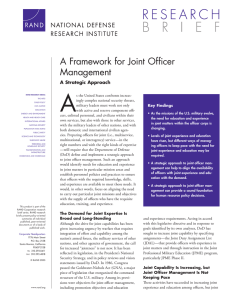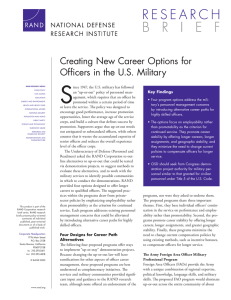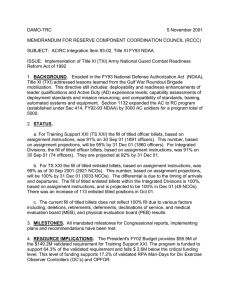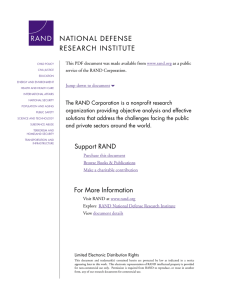6 The RAND Corporation is a nonprofit from
advertisement
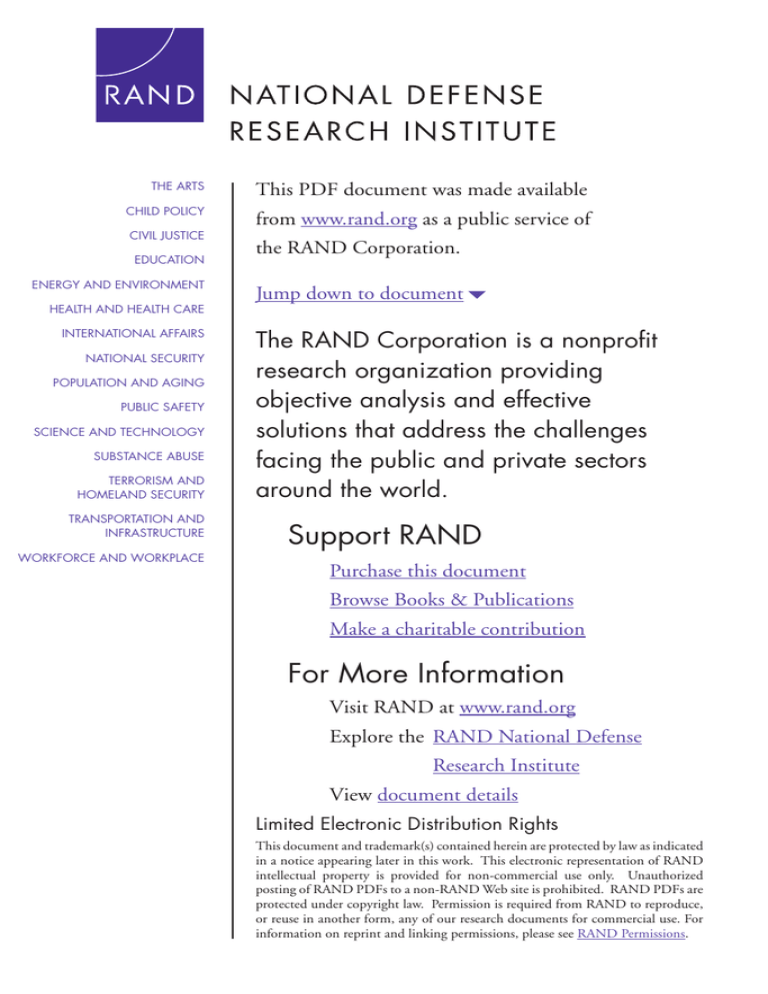
THE ARTS This PDF document was made available CHILD POLICY from www.rand.org as a public service of CIVIL JUSTICE EDUCATION ENERGY AND ENVIRONMENT HEALTH AND HEALTH CARE INTERNATIONAL AFFAIRS NATIONAL SECURITY POPULATION AND AGING PUBLIC SAFETY SCIENCE AND TECHNOLOGY SUBSTANCE ABUSE TERRORISM AND HOMELAND SECURITY TRANSPORTATION AND INFRASTRUCTURE WORKFORCE AND WORKPLACE the RAND Corporation. Jump down to document6 The RAND Corporation is a nonprofit research organization providing objective analysis and effective solutions that address the challenges facing the public and private sectors around the world. Support RAND Purchase this document Browse Books & Publications Make a charitable contribution For More Information Visit RAND at www.rand.org Explore the RAND National Defense Research Institute View document details Limited Electronic Distribution Rights This document and trademark(s) contained herein are protected by law as indicated in a notice appearing later in this work. This electronic representation of RAND intellectual property is provided for non-commercial use only. Unauthorized posting of RAND PDFs to a non-RAND Web site is prohibited. RAND PDFs are protected under copyright law. Permission is required from RAND to reproduce, or reuse in another form, any of our research documents for commercial use. For information on reprint and linking permissions, please see RAND Permissions. This product is part of the RAND Corporation monograph series. RAND monographs present major research findings that address the challenges facing the public and private sectors. All RAND monographs undergo rigorous peer review to ensure high standards for research quality and objectivity. A Strategic Approach to Joint Officer Management Analysis and Modeling Results Margaret C. Harrell, Harry J. Thie, Sheila Nataraj Kirby, Al Crego, Danielle M. Varda, Thomas Sullivan Prepared for the Office of the Secretary of Defense Approved for public release; distribution unlimited NATIONAL DEFENSE RESEARCH INSTITUTE The research described in this report was prepared for the Office of the Secretary of Defense (OSD). The research was conducted in the RAND National Defense Research Institute, a federally funded research and development center sponsored by the OSD, the Joint Staff, the Unified Combatant Commands, the Department of the Navy, the Marine Corps, the defense agencies, and the defense Intelligence Community under Contract W74V8H-06-C-0002. Library of Congress Cataloging-in-Publication Data is available for this publication. 978-0-8330-4750-2 The RAND Corporation is a nonprofit research organization providing objective analysis and effective solutions that address the challenges facing the public and private sectors around the world. RAND’s publications do not necessarily reflect the opinions of its research clients and sponsors. R® is a registered trademark. © Copyright 2009 RAND Corporation Permission is given to duplicate this document for personal use only, as long as it is unaltered and complete. Copies may not be duplicated for commercial purposes. Unauthorized posting of RAND documents to a non-RAND Web site is prohibited. RAND documents are protected under copyright law. For information on reprint and linking permissions, please visit the RAND permissions page (http://www.rand.org/publications/permissions.html). Published 2009 by the RAND Corporation 1776 Main Street, P.O. Box 2138, Santa Monica, CA 90407-2138 1200 South Hayes Street, Arlington, VA 22202-5050 4570 Fifth Avenue, Suite 600, Pittsburgh, PA 15213-2665 RAND URL: http://www.rand.org To order RAND documents or to obtain additional information, contact Distribution Services: Telephone: (310) 451-7002; Fax: (310) 451-6915; Email: order@rand.org Summary Background and Purpose of Project Since 1991, successes in Iraq (Operations Desert Shield and Storm), Bosnia, and Afghanistan (among others), and more recently in Operation Iraqi Freedom, have testified to the effectiveness of the joint military force and its warfighting potential. The ways in which joint officers are currently educated and trained are largely governed by Title IV of the Goldwater-Nichols Act of 1986 (GNA).6,7 However, it is increasingly recognized that the current approach to joint matters needs to evolve from its current static format to a more dynamic approach that broadens the definitions of joint matters and joint qualifications and 6 Public Law 99-433, Goldwater-Nichols Department of Defense Reorganization Act of 1986, October 1, 1986. 7 Throughout this report we use the term joint as shorthand to refer to the management of officers with education and assignments in joint matters. DoD defines joint matters as Matters related to the achievement of unified action by multiple military forces in operations conducted across domains such as land, sea, or air, in space, or in the information environment, including matters relating to national military strategy; strategic planning and contingency planning; command and control of operations under unified command; national security planning with other departments and agencies of the United States; and combined operations with military forces of allied nations. In the context of joint matters, the term “multiple military forces” refers to forces that involve participation from the armed forces and one or more of the following: other departments and agencies of the United States; the military forces or agencies of other countries; nongovernmental persons or entities. (DoD, “DoD Joint Officer Management Program,” DoD Instruction 1300.19, August 21, 2008.) xix xx A Strategic Approach to Joint Officer Management: Analysis and Modeling allows for multiple paths to growing joint officers.8 DoD’s most recent strategic plan for joint officer management and joint officer development states eloquently, Joint Task Forces (JTFs) now define the way we array our armed forces for both war and operations other than war. The effectiveness of joint operations is no longer simply the integration and/or interoperability of two or more military services; it requires the synergistic employment of forces from multiple services, agencies, and nations. Non-governmental agencies and commercial enterprises must now be routinely combined with these traditional military forces and the interagency component to achieve national objectives. Such a dynamic and varied environment demands flexibility, responsiveness, and adaptability not only from the individual Soldiers, Sailors, Airmen, and Marines, but also from the processes supporting them.9 In 2003, DoD asked the RAND National Defense Research Institute to undertake an analysis that would provide overarching guidance on officer training and development in joint matters. The results of that effort were documented in Framing a Strategic Approach for Joint Officer Management.10 That work indicated that the next step in the approach to joint officer management was to implement the strategic plan, a step that would require extensive data on the billets that require or provide joint experience. The prior report outlined a plan to collect the relevant data. This plan was implemented by the sponsor office, which conducted a Web-based survey of individuals serving in joint or potentially 8 U.S. General Accounting Office, Joint Officer Development Has Improved, But a Strategic Approach Is Needed, Washington, D.C., GAO-03-238, 2002; Booz Allen Hamilton, Independent Study of Joint Officer Management and Joint Professional Military Education, McLean, Va., 2003. 9 DoD, Strategic Plan for Joint Officer Management and Joint Professional Military Education, 2006, p. 3. 10 Harry J. Thie, Margaret C. Harrell, Roland J. Yardley, Marian Oshiro, Holly Ann Potter, Peter Schirmer, and Nelson Lim, Framing a Strategic Approach for Joint Officer Management, Santa Monica, Calif.: RAND Corporation, MG-306-OSD, 2005. Summary xxi joint billets in the summer of 2005. These billets included those on the current JDAL, formally recognized in law as providing joint experience and thus eligible for joint duty credit; those in external organizations with some billets on the JDAL; and internal service billets nominated by the services as “potentially joint” that are currently excluded from consideration for joint duty credit.11 A companion report by Kirby et al. provides an overview of the survey responses.12 In the current report, we use data from the 2005 survey to examine the demand for and supply of “jointness” in billets. The report focuses on three areas: (1) analyzing the characteristics that measure “jointness” of a billet and using that analysis to identify billets with joint content; (2) determining whether sufficient numbers of officers with joint education, training, and experience are likely to be available to satisfy DoD’s needs; and (3) exploring whether and how the experiences of selected communities of officers—for example, those assigned to billets dealing with acquisition matters—differ from those of their peers. Findings from these analyses were provided to the sponsor and used in developing the DoD’s new Strategic Plan for Joint Officer Management and Joint Professional Military Education, issued in April 2006,13 and the implementation plan for the new joint officer qualification system, issued in March 2007.14 Because the work presented here predates the new system now being implemented, we present the recommendations as they were initially provided to the sponsor. Many of these recommendations have been incorporated into the new joint officer qualification system. 11 Internal service organizations are those that consist almost exclusively of personnel from a single service, and whose command structure is of that service (e.g., combat units, service staff). External organizations are those that include individuals from multiple services, and whose command structure is inclusive of multiple services (e.g., defense agencies, combatant commands, JTFs, joint staff). 12 Sheila Nataraj Kirby, Al Crego, Harry J. Thie, Margaret C. Harrell, Kimberly Curry Hall, and Michael S. Tseng, Who Is “Joint”? New Evidence from the 2005 Joint Officer Management Census Survey, Santa Monica, Calif.: RAND Corporation, TR-349-OSD, 2006. 13 DoD, 2006. 14 DoD, Joint Qualification System Implementation Plan, March 2007. xxii A Strategic Approach to Joint Officer Management: Analysis and Modeling Findings from the 2005 Joint Officer Management Census Survey The analyses reported in Kirby et al. (2006) used two major classification schemes to examine differences in survey responses. In the first scheme, billets were characterized as JDAL billets, non-JDAL billets in external organizations that have some JDAL billets, or internal service billets. The second scheme analyzed billets according to the major billet organization in which the billet was located. The survey gathered information by asking about billet characteristics that are generally regarded as defining jointness. This information included the types of tasks, whether or not the billet was supervised by the same service, the frequency and number of interactions with organizations and individuals from other services, the perceived need for prior joint experience or joint education, and the types of joint experience provided by the billet. Four tasks were selected as representing “highly joint” activities: (1) providing strategic direction and integration, (2) developing/ assessing joint policies, (3) developing/assessing joint doctrine, and (4) fostering multinational, interagency, or regional relations. Close to 80 percent of JDAL officers performed one or more of these tasks, and 27 percent of JDAL officers performed at least three of these tasks. In contrast, only 45 percent of officers in internal service billets performed any of these joint tasks, and less than 10 percent of officers in internal service billets performed three or more of these tasks. The analysis also considered the extent to which officers were interacting with organizations or personnel from other services. Officers in JDAL billets reported the highest frequency of interactions with organizations in other services. When considered by organization, officers working in Office of the Secretary of Defense (OSD) or Joint Staff billets had the most non-own–service organizational interactions compared with officers in internal service billets. Likewise, officers in JDAL and non-JDAL external organization billets had more reported interactions with individuals from other services than did officers in internal service billets. Related to this, close to 80 percent of JDAL billets and 75 percent of non-JDAL external billets were supervised by personnel Summary xxiii from another service, compared with about 20 percent of internal billets surveyed. In terms of joint experience (multiservice, multinational, and interagency), the analysis found that 87 percent of officers in JDAL billets reported that they gained significant experience in multiservice matters, and 65 to 75 percent reported gaining significant experience in multinational and interagency matters. Officers in non-JDAL external billets were more likely to gain multinational than multiservice or interagency expertise. Officers serving in service-nominated billets were less likely to gain these types of expertise, compared with other surveyed officers. The survey asked officers whether Phase II JPME (JPME II) and prior joint experience were either required or desired to perform the duties of the billet successfully. The majority of all officers surveyed, regardless of organization, reported a need for joint education and experience. Even 70 to 80 percent of officers serving in internal service billets indicated such a need. Identifying Attributes of Joint Billets One of the main purposes of the new study was to examine and identify the characteristics of joint billets with a view to developing criteria that could be used to classify future billets as suitable for the JDAL. We used a number of different classification methods to try to identify clusters of variables that appeared to characterize “joint” billets; to check the robustness of these findings across different samples and different techniques; and to identify “misclassified” cases, in particular, groups of non-JDAL billets in external organizations and servicenominated billets that appeared to share the attributes of JDAL billets. We started with one major underlying presumption—that JDAL billets characterize “joint” billets, so non-JDAL billets that rank high on similar characteristics might be billets that could qualify their incumbents for joint duty credit. We explored three main avenues in our research: (1) classification techniques, such as classification and regression tree analysis (CART) xxiv A Strategic Approach to Joint Officer Management: Analysis and Modeling and nonparametric kernel classification, to identify variables that offer some ability to discriminate among groups; (2) exploration of correlations among the data to see if characteristics could be pared down to some smaller subset of underlying attributes or “factors” through factor analysis; and (3) logistic regression models to identify factors that appeared to distinguish JDAL billets from non-JDAL billets and to use these factors to identify a set of non-JDAL billets that were “closer” to JDAL billets than non-JDAL billets. These variables used in the analyses included (1) types of tasks performed; (2) substitutability of civilians or other service members in a given billet; (3) types of knowledge, education, and experience required for or provided by the billet; (4) interactions and service with organizations and personnel outside of own service; and (5) other characteristics of the billets in terms of assignment, location, and pays. Table S.1 identifies the variables that were significant in classifying and distinguishing among the three types of billets—JDAL, external organization, and service-nominated. Because the factor analysis had identified natural groupings of the variables, we grouped these variables according to the nine factors identified by the factor analysis. Some variables were robust across the different techniques in discriminating billets. These included (1) whether the billet involved serving with other military departments; (2) whether the billet was primarily tactical, operational, or strategic in nature; (3) the types of experiences provided by the billet, especially multiservice and interagency experience; (4) whether the billet involved having frequent interactions with different types of non-own–service personnel;15 and (5) whether the billet involved frequent interactions with non-own–service organizations. The table does not make an attempt to rank the relative importance of the variables across the various methods. Each method, of course, uses a different criterion for determining significance. For example, CART uses cross-validation and pruning, while logistic regression uses traditional significance testing. Ranking the variables in order of importance could be done through simulation methods, which were outside 15 Non-own–service personnel include DoD military or civilian personnel from a different service than the referent individual. Summary xxv Table S.1 Summary of Variables Selected by Various Analyses as Important in Classification of Billets, Organized by Factor Logistic Regression (JDAL Versus ServiceNominated Billets) Logistic Regression (JDAL Versus Non-JDAL External Organization Billets) Currently serving at home base √ √ Currently receiving family separation allowances √ √ Variable CART Heuristic Approach Deployment Currently receiving hostile pay Currently receiving hardship pay √ Currently receiving combat tax exclusion √ Joint tasks Perform “develop joint doctrine” task √ √ Perform “develop joint policies” task Task of developing joint doctrine important to job Task of developing joint policies important to job √ Job assessment Billet gives significant experience in multiservice matters √ √ Billet gives significant experience in multinational matters Billet gives significant experience in interagency matters √ √ √ √ √ √ xxvi A Strategic Approach to Joint Officer Management: Analysis and Modeling Table S.1—Continued Logistic Regression (JDAL Versus ServiceNominated Billets) Logistic Regression (JDAL Versus Non-JDAL External Organization Billets) Prior joint experience desired or required for job performance √ √ Civilian could perform billet duties effectively √ √ √ √ Variable Billet summary (primarily tactical, operational, or strategic in nature) CART Heuristic Approach √ Number of knowledge elements required for job Number of knowledge elements in which job incumbent will gain proficiency by serving in job √ √ √ Number of Level 1 or Level 2 non-own– service supervisors √ Job does not require unique knowledge of own service √ Billet involves serving full-time with members from another military department √ Number of types of personnel with whom incumbent interacts frequently √ √ √ √ √ √ Perform “foster complex relations” task √ √ Task of fostering complex relations is important to job √ √ Organizational interactions Summary xxvii Table S.1—Continued Variable CART Heuristic Approach Logistic Regression (JDAL Versus ServiceNominated Billets) Perform “strategic direction and integration” task √ Task of providing strategic direction and integration important to job √ Serving in a JTF Headquarters Staff billet √ Logistic Regression (JDAL Versus Non-JDAL External Organization Billets) √ Serving in a JTF subordinate organization billet Serving in a JTF service component billet √ √ Multinational assignment Billet involves fulltime service with armed forces of another country or international military/ treaty organization √ Assigned simultaneously to own service and joint, combined, or multinational organization √ Other variables JPME II desired or required for job performance Number of non-own– service organizations with whom incumbent interacts frequently √ √ √ √ xxviii A Strategic Approach to Joint Officer Management: Analysis and Modeling the scope of the project. Our purpose here was more limited. We were interested in identifying characteristics that appeared to discriminate “more-joint” billets from “less-joint” billets across a variety of statistical classification methods. The objective was to present policymakers with a robust range of characteristics that they could use to identify positions for which joint duty credit should be awarded or which are good candidates for the JDAL. Policymakers may choose to assign different weights to the variables in determining jointness, something we were not able to do in our analysis. There was a good deal of consistency in the variables identified by the various methods as important discriminators of billets that resemble JDAL billets. The list of variables may prove useful in developing guidelines and criteria for evaluating individual billets. Currently, officers receive joint credit for serving in positions on the JDAL. As we have pointed out elsewhere, one frequent criticism of the current system is that officers are serving in non-JDAL assignments that provide a rich joint experience but do not grant the officers joint credit.16 Likewise, there are officers serving in assignments on the JDAL that may not provide what some would consider a joint experience, either because of the content of their work or because of limited interaction with other services, nations, or agencies. Our analysis provides evidence to support both these assertions. Determining Whether There Are Sufficient JointExperienced Officers to Meet the Demand for Them We modeled the extent to which there is a sufficient number of officers with joint experience to satisfy the demand for such officers. The key inputs included the number of billets that require prior joint experience, the number of billets that provide officers with joint experience, and the management model used to assign, promote, and retain those offi- 16 Thie at al., 2005; Harry J. Thie, Margaret C. Harrell, Sheila Nataraj Kirby, Al Crego, Roland J. Yardley, and Sonia Nagda, Framing a Strategic Approach for Reserve Component Joint Officer Management, Santa Monica, Calif.: RAND Corporation, MG-517-OSD, 2006. Summary xxix cers. This analysis included excursions for four communities of officers: Army Infantry, Navy Surface Warfare officers, Air Force Space and Missile officers, and Marine Corps ground officers. For each community, we explored two supply situations. First, we considered the implications if only officers serving in billets currently on the JDAL received valid joint experience, and, second, we considered the implications of also acknowledging those billets for which survey respondents reported that they received significant joint experience. For each community, we also explored the implications of three demand situations: demand for joint experience that was limited only to today’s critical billets; demand to fill all the billets that survey respondents indicated required prior joint experience; and demand to fill the billets that survey respondents indicated either required or desired prior joint experience. We matched each supply possibility to each demand possibility, using three different management frameworks (further discussed below). This modeling and analysis indicates that whether there are sufficient numbers of joint-experienced officers depends more on the assumptions made about demand than about supply. There will likely not be any difficulty developing and managing sufficient joint officers to fill critical billets—those currently acknowledged as requiring prior joint experience. It will be more challenging to fill billets that survey respondents indicated would benefit from prior joint experience, and it does not appear feasible to assign an officer with prior joint experience to every billet for which prior joint experience is required or desired. One challenge of joint officer management is that so many of the billets that might benefit from prior joint experience also provide joint experience. Thus, one management tradeoff is determining whether to maximize the performance in those billets by assigning officers with prior joint experience, or whether to provide other officers the opportunity to gain joint experience. Our analysis found that it was considerably easier to satisfy the identified need for joint-experienced officers if officers could obtain valid joint experience from billets that were identified by survey respondents as providing a valid joint experience, rather than only from billets on the current JDAL. xxx A Strategic Approach to Joint Officer Management: Analysis and Modeling The analysis reported here was based, in part, on the differences among the three management frameworks, which determined how officers were assigned, promoted, and retained: (1) the managing leadership succession model, in which officers are managed as future military leaders and thus experience shorter joint assignments and higher promotion rates; (2) a managing competencies system, which places emphasis on developing intensely experienced officers in joint matters and would result in something that might be considered a joint cadre that experienced longer and repeated joint assignments; and (3) a managing skills system, which would distribute joint experience throughout the officer corps. Throughout this analysis, our determination of “sufficient to meet demand” varies by the communities examined and the management model employed. For example, the managing leadership succession model, in which more officers serve in shorter joint assignments and then are retained and promoted, provides the greatest ratio of jointexperienced officers to billets. However, other management frameworks might require lower ratios. For example, joint officers in a managing competencies framework would be expected to serve multiple joint assignments, and thus there may be fewer competing opportunities for each individual officer. Recommendations Currently, officers receive joint credit for serving in positions on the JDAL. However, our analysis supports two frequent criticisms. First, officers are serving in non-JDAL assignments that provide a rich joint experience but do not grant the officers joint credit. Second, there are officers serving in assignments on the JDAL that may not provide what some would consider a joint experience, either because of the content of their work or because of limited interaction with other services, nations, or agencies. In a previous report, we suggested that a point system be considered in which individuals could petition to receive credit for joint duty assignments not currently included on the JDAL by developing Summary xxxi portfolios to be evaluated by officer boards.17 The variables associated with jointness identified in the statistical analysis in this report would provide a good start at outlining the guidelines for putting together such portfolios and criteria for evaluating them. The best management system in terms of feasibility, management flexibility, and movement toward the Chairman’s vision for joint officer development18 is to recognize that a larger number of billets require prior experience and to use a modified JDAL system that allows individual officer assessment of joint experience and accredits officers accordingly. Our recommendations include the following: t Maintain a billet-based system that is an organization-based system and supplement it with an individual-based system. In other words, judge all the billets within an organization to be equally joint, and supplement this system with an evaluation of individuals’ cumulative joint experiences gained elsewhere. t When implementing an individual-based system, recognize intensity of experience when considering those in either non-JDAL billets or those in JDAL billets with tenure appeals. t Because they include joint content, consider O-3 billets for inclusion on the JDAL and consider experience in O-3 billets when assessing the joint experience of individuals. t Consider recency of experience when measuring an individual’s experience. Thus, if a senior officer’s only joint experience was gained as an O-3, that prior assignment may not provide sufficient prerequisite experience for important senior joint assignments. t Consider managing (and tracking relevant experience) separately for multiservice, multinational, and interagency matters. t Reconsider the exclusion of certain occupational groups from the JDAL. t When determining tenure restrictions for joint credit, recognize that it is in the best interest of the joint organization to have 17 18 Thie et al., 2006. Joint Chiefs of Staff, CJCS Vision for Joint Officer Development, Washington, D.C., November 2005. xxxii A Strategic Approach to Joint Officer Management: Analysis and Modeling longer-tenured personnel, but that the average individual gains acculturation and joint experience quickly. Thus, tenure restrictions may benefit the organization more but may be less relevant to determining who has received a valid joint experience. Many of these recommendations have been incorporated into the new joint officer qualification system implemented in October 2007. Abbreviations CART classification and regression tree analysis CENTCOM U.S. Central Command COCOM combatant command CSA combat support agency DMDC Defense Manpower Data Center DoD U.S. Department of Defense GNA Goldwater-Nichols Act of 1986 JDAL Joint Duty Assignment List JOM survey Joint Officer Management Census survey JPME Joint Professional Military Education JPME II Phase II Joint Professional Military Education JPO Joint Program Office JSO Joint Specialty Officer JTF Joint Task Force OSD Office of the Secretary of Defense xxxiii
